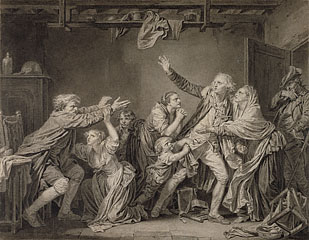• Use one word to describe this image. What has the artist done to elicit this response?
(Tense or dramatic. The compressed figures in a confined space along with their body positions and the disheveled setting
elicit these descriptions.)
• What are the different emotions displayed in this scene? (Anger, worry, amusement, sadness.)
• Who are the dominant figures in this scene? How can you tell? (The father and the son are dominant. Their raised arms and
dominant stances draw attention to these figures.)
• Although depicting a contemporary scene, the artist was influenced by ancient sculptural
friezes. What elements of this
drawing have frieze-like qualities? (The composition, with figures lined up in one plane. The sculptural rendering of the
cramped figures and their clothing which is reminiscent of
classical drapery, along with the exaggerated gestures, taken from
ancient sources.)
• Greuze compressed eight figures into a small space in this composition. What type of mood does this create? How does this impact
the experience of the viewer? (This creates a tense and action-packed scene that draws in the viewer.)
• Greuze uses contrasting elements to create tension in this scene. Where can you find examples of this? (Light and dark, soft
cloth and hard walls and floor, stoic expressions and animated gestures, small room and large figures.) |
In this dramatic scene a father extends his hands in anger toward his son, who has just enlisted in the army. A young woman kneels
in front of the father, trying to pacify him, while the mother embraces her son. Even the baby clings anxiously to his brother's
coattails. The son stretches out his arm as he advances toward the door, where the recruiting sergeant contemplates this spectacle
with bemused indifference. Broad gestures, theatrical poses, and striking facial expressions communicate variations of two primary
emotions: anger and distress.
This drawing corresponds closely with Jean-Baptiste Greuze's famous painting of the same title in the Musée du Louvre, Paris,
painted in 1777–1778. A pendant picture, also in the Louvre, shows the same family grieving at the father's deathbed. The
son, who has now returned home, repents too late of his misconduct. This drawing and its pendant explore the concept of national
versus filial piety. Greuze suggests that the seemingly honorable decision to leave one's family in order to serve the larger
society is not, in this case, the right one. It would be difficult for a family of women and children to survive with only an
elderly and infirm man to provide for them. As the only able-bodied man of the house, the son should have stayed to care for the
home, as he is to find out later.
The overt emotionalism and potentially antipatriotic undertones of this work seem to fly in the face of the Neoclassical ideal,
both formally and conceptually. However, Greuze offers insight into another strain of Neoclassicism, one that used the forms of
ancient art but imbued them with a realism that reflected the values of the Enlightenment. Artists like the sculptor
Jean-Antoine Houdon (1741–1828) and Greuze elevated the stature of intellectuals and the middle class by executing portraits and scenes
of everyday life with a monumentality previously reserved for
history painting.
About the Artist
Jean-Baptiste Greuze, 1725–1805
French
"Courage, my friend Greuze, go ahead and moralize with your paintbrush, and always continue in this manner!" enthused the art
critic Denis Diderot. After training in Lyon, Jean-Baptiste Greuze arrived in Paris in 1750, where he sporadically attended the
Académie Royale. His 1755
Salon debut was a triumph, but the acclamation turned his head. He antagonized many people,
including fellow artists, which later proved disastrous.
Greuze introduced a Dutch-influenced realism into French
genre painting and portraiture. Through vivid facial expressions and
dramatic gestures, his moralizing drawings and paintings exemplified the new idea that art should reflect real life. These works
captured the details of setting and costume, "spoke to the heart," educated viewers, and aimed to make them "virtuous." Greuze's
moralistic storytelling was greatly influenced by the popularity of contemporary English novels, such as those by Jane Austen,
and the writings of Enlightenment philosophers such as Jean-Jacques Rousseau, who emphasized many of the same moral, social, and
political topics in their work.
During the 1770s Greuze enjoyed a widespread reputation and engravings after his paintings were widely distributed, but his wife
embezzled most of the proceeds. By the 1780s his popularity had declined. After enduring poverty and neglect for 20 years, he died
just as his work was being reevaluated and appreciated anew by the critics.
|
